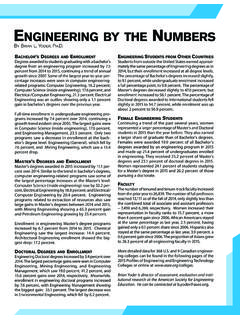Transcription of TECHNICAL PAGES Basics of deionization - WET USA
1 TECHNICAL PAGES precharged with hydrogen ions on itsexchange resin is typically made fromstyrene containing quaternary ammoni-um groups, which are positivelycharged. Despite its positive charge, it iscalled an anionic resin, referring to theanions that it will resin typically comes in thehydroxide ion (OH-) form, meaning it isprecharged with hydroxide ions on itsexchange variations Cationic resin is referred to asstrong acid or weak acid. Anionic resin is referred to as strongbase or weak base. The basic difference is the weakly ion-ized resin will exchange only the weakions, where as a strongly ionized resinwill exchange both weak and strong ionsbut at the expense of a reduced strong base anion comes in Type 1or Type 2.
2 Type 1 can remove silica andCO2better than Type 2 but at a are other variations of resins toconsider, with each providing its ownadvantages and disadvantages such asthermal, physical and chemical stability,oxidation and organic fouling resist-ance, kinetics and costs. One mustchoose the proper type of resin to fit and mixed-bedsDeionizers come in dual-beds ormixed-beds. In a dual-bed system, thecationic resin and the anionic resin are inseparate vessels, where as in a mixed-bed the cationic and the anionic resinsare mixed in a single vessel. This is alsocalled a single-bed a dual-bed DI (see Figure 1) water ispassed through the cationic vessel wherethe cations in the water are exchangedJanuary 2004 Technology 39 deionization (DI), also referred toas demineralization, is an ion-exchange process wherein virtu-ally all of the dissolved ions in the watercan be removed, producing pure on the type and combina-tion of equipment, DI can produce apurity from 100,000 ohms/cm to 18 mil-lion ohms/cm (or mega-ohms/cm).
3 Types of resinA deionizer uses two opposing chargedresins (cationic and anionic). While thecationic resin removes the cations, theanionic resin removes the cationic resin is typically madefrom styrene containing sulfonic acidgroups, which are negatively the resin is actually negativelycharged, it is called a cationic resin,referring to the cations that it resin typically comes in thehydrogen ion (H+) form, meaning it isTo design an effective system, dealers should know the application, desired purity and the existing impurities in the Mario C. Uy and Domingo A. MesaBasics of deionizationFigure 1 Typical dual-bed deionizerSizing the deionizerCationic resin is rated at about 20,000grains per ft3at 2-gallons HCl regenerantper ft3of resin.
4 Anionic resin is rated atabout 12,000 grains per ft3at 1-gallonNaOH regenerant per ft3of resin Despite the higher capacity of thecationic resin, dual-beds typically comewith equal amount of cationic and anionicresin. In essence, the cationic vessels areoversized because they also supply theregenerant water for the anionic come with a 40/60 blendof cationic and anionic resin. and (Continued on page 40)with the hydrogen ions from the resin. The cationic resin, having a greateraffinity for the cations, releases the hydro-gen ions while grabbing the cations. Thereleased hydrogen ions form acid withthe remaining anions in the water is then passed through theanionic vessel where the anions are nowexchanged with the hydroxide ions fromthe resin.
5 Similarly, the anionic resin,having a greater affinity for the anions,releases the hydroxide ions while grab-bing the released hydrogen ions (H+) fromthe cationic vessel and hydroxide ions(OH-) from the anionic vessel now com-bine to form HOH or H2O. Some of the ions will slip by andwon t be exchanged. If the DI water canbe passed through the dual-bed again,the deionizer will have another chanceto remove the ions that slipped time this pass is repeated, moreions are removed and exchanged, pro-ducing an even purer water. In a mixed-bed, the water passes through thecationic resin and the anionic resinrepeatedly, virtually for an infinite resulting water is usually mixed-bed can produce over 10M-ohm water, whereas a dual-bed typical-ly produces only 50K-ohms to 100K-ohms water.
6 Another variation is a combination ofdual-bed and mixed-bed, where themixed-bed is used as a polisher. Such aset-up can produce ultrapure water upto 18 mega-ohm/cm. Recycling DI waterIf the flow through the deionizer istemporarily halted, the water in the ves-sels will begin to take back the impureions from the resin. When the flow isresumed, the first few gallons will usu-ally be below specs. To prevent this, the DI water can berecycled back at a fraction of the serviceflow rate to the front of the deionizer tokeep the water moving and the purityup (See Figure 2). This method is also used when DIwater is stored after the deionizer. If thewater is not used immediately, it willTECHNICAL PAGES40 Water 2004 Figure 2 A fraction of the DI water is recirculated to the front of the deionizer to maintain the water s purity.
7 The Information Source for Water Treatment ProfessionalsWaterWaterWaterThe #1 Industry Trade PublicationBuilding a better industry through innovation and competitionHumphrey S. Tyler13 Century Hill DriveLatham, NY ve maintained this tradition of innovativeservices to the POU/POE marketplacebecause like thousands of our readersand advertisers we are entrepreneurial,and we believe that creative change andaggressive competition develops a strongerand more vibrant industry. Firstto have its circulation audited by BPA International, a third-party auditing bureau. Firstto offer overnight delivery of reader inquiry salesleads to advertisers via faxes. Firstto publish an exhibitor guide for the WQA Show. Firstto publish a Spanish edition.
8 Firstto have a website. Firstto offer a daily e-news tradition of being first: absorb gasses like CO2and other air-borne particles,reducing the water s resistivity. To prevent the water from falling below specs, itcan also be recycled back to front of the deionizer forsimilar the resins will expire, as all the hydro-gen and/or hydroxide ions are expelled and all theexchange sites are filled with impure ions. Thereafter,the deionizer will no longer remove any subsequentimpure ions, allowing them to leak through, reducingwater purity. The most common indicator of a deionizer expira-tion is a sudden and significant drop in the resistivityof the DI water. There are other indicators. When the cationic resinexpires, the first ion to leak through will be sodium(Na+).
9 When the anionic resin expires, the first ions toleak through will be silica (SiO2) and/or carbonatealkalinity (CO3-2). RegenerationTo bring the water purity back to spec, the deioniz-er must be regenerated. Most deionizers are regener-ated based on resistivity, while others are based on theion cationic resin is regenerated with acid toreplace the hydrogen ions. The preferred acid ishydrochloric acid (HCl), typically 20oBe (32 percent)at about 2-gallons per ft3of resin. The anionic resin is regenerated with caustic toreplace the hydroxide ions. The preferred caustic isa rayon or mercury grade sodium hydroxide(NaOH), typically 50oBe (50 percent) at about 1-gal-lon per ft3of resin. A dual-bed can be regenerated in series or parallel: January 2004 Technology 41 Circle fast action no.
10 204 Non-ionic treatmentDeionizers do not remove non-ionic solids such ashydrophobic organic and some biological matters. Sincethese particles may be present in water, it would be pru-dent to add other equipment such as multi-media filters,activated carbon filters, RO and/or UV light to remove thenon-ionic solids and to keep microbiological growth andfouling under the water contains significant amount of dissolvedgasses like CO2, removing them mechanically viadegasifiers may be more cost efficient. and (Concluded on page 42)Pipe scalebeforeThree monthslaterAquaVantage THE INTELLIGENT CHOICE FORHARD WATER TREATMENT!Be the first to offer your customers thebest solution to their hard water prob-lems, and the problems associated withsalt dramatic savings,great convenience, proven technologyand a host of health benefits.



